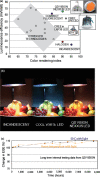Colloidal quantum dot light-emitting devices
- PMID: 22110863
- PMCID: PMC3215219
- DOI: 10.3402/nano.v1i0.5202
Colloidal quantum dot light-emitting devices
Abstract
Colloidal quantum dot light-emitting devices (QD-LEDs) have generated considerable interest for applications such as thin film displays with improved color saturation and white lighting with a high color rendering index (CRI). We review the key advantages of using quantum dots (QDs) in display and lighting applications, including their color purity, solution processability, and stability. After highlighting the main developments in QD-LED technology in the past 15 years, we describe the three mechanisms for exciting QDs - optical excitation, Förster energy transfer, and direct charge injection - that have been leveraged to create QD-LEDs. We outline the challenges facing QD-LED development, such as QD charging and QD luminescence quenching in QD thin films. We describe how optical downconversion schemes have enabled researchers to overcome these challenges and develop commercial lighting products that incorporate QDs to achieve desirable color temperature and a high CRI while maintaining efficiencies comparable to inorganic white LEDs (>65 lumens per Watt). We conclude by discussing some current directions in QD research that focus on achieving higher efficiency and air-stable QD-LEDs using electrical excitation of the luminescent QDs.
Keywords: displays; lighting; nanocrystals; optoelectronics.
Figures




Similar articles
-
Quantum dots for light emitting diodes.J Nanosci Nanotechnol. 2013 May;13(5):3173-85. doi: 10.1166/jnn.2013.7146. J Nanosci Nanotechnol. 2013. PMID: 23858829 Review.
-
Advances in Quantum-Dot-Based Displays.Nanomaterials (Basel). 2020 Jul 6;10(7):1327. doi: 10.3390/nano10071327. Nanomaterials (Basel). 2020. PMID: 32640754 Free PMC article. Review.
-
Performance of light-emitting-diode based on quantum dots.Nanoscale. 2013 Jun 21;5(12):5205-14. doi: 10.1039/c3nr00496a. Nanoscale. 2013. PMID: 23695105
-
Recent Progress in Quantum Dot Based White Light-Emitting Devices.Top Curr Chem (Cham). 2016 Aug;374(4):42. doi: 10.1007/s41061-016-0041-3. Epub 2016 Jun 14. Top Curr Chem (Cham). 2016. PMID: 27573394 Review.
-
Stability of Quantum Dots, Quantum Dot Films, and Quantum Dot Light-Emitting Diodes for Display Applications.Adv Mater. 2019 Aug;31(34):e1804294. doi: 10.1002/adma.201804294. Epub 2019 Jan 16. Adv Mater. 2019. PMID: 30650209 Review.
Cited by
-
Laser-induced growth of nanocrystals embedded in porous materials.Nanoscale Res Lett. 2013 Jun 6;8(1):266. doi: 10.1186/1556-276X-8-266. Nanoscale Res Lett. 2013. PMID: 23742134 Free PMC article.
-
Hypervalent surface interactions for colloidal stability and doping of silicon nanocrystals.Nat Commun. 2013;4:2197. doi: 10.1038/ncomms3197. Nat Commun. 2013. PMID: 23893292 Free PMC article.
-
Unprecedented surface stabilized InP quantum dots with bidentate ligands.RSC Adv. 2020 Mar 23;10(19):11517-11523. doi: 10.1039/c9ra10933a. eCollection 2020 Mar 16. RSC Adv. 2020. PMID: 35495314 Free PMC article.
-
Nanotechnology in Fire Protection-Application and Requirements.Materials (Basel). 2021 Dec 18;14(24):7849. doi: 10.3390/ma14247849. Materials (Basel). 2021. PMID: 34947443 Free PMC article. Review.
-
Optical and Electrical Analysis of Annealing Temperature of High-Molecular Weight Hole Transport Layer for Quantum-dot Light-emitting Diodes.Sci Rep. 2019 Jul 17;9(1):10385. doi: 10.1038/s41598-019-46858-6. Sci Rep. 2019. PMID: 31316166 Free PMC article.
References
-
- Murray CB, Norris DJ, Bawendi MG. Synthesis and characterization of nearly monodisperse CdE (E=sulfur, selenium, tellurium) semiconductor nanocrystallites. J Am Chem Soc. 1993;115:8706–15.
-
- Coe S, Woo WK, Bawendi MG, Bulović V. Electroluminescence from single monolayers of nanocrystals in molecular organic devices. Nature. 2002;420:800–3. - PubMed
-
- Tekin E, Smith PJ, Hoeppener S, Berg AMJ van de, Susha AS, Rogach AL, et al. Inkjet printing of luminescent CdTe nanocrystal-polymer composites. Adv Funct Mat. 2007;17:23–8.
-
- Wood V, Panzer ML, Long J, Bradley MS, Halpert JE, Bawendi MG, et al. Inkjet printing of polymer-quantum dot composites for full color AC electroluminescent displays. Adv Mater. 2009;21:2151–5.
-
- Kim LA, Anikeeva PO, Coe-Sullivan SA, Steckel JS, Bawendi MG, Bulović V. Contact printing of quantum dot light-emitting devices. Nano Lett. 2008;8:4513–7. - PubMed
LinkOut - more resources
Full Text Sources
Other Literature Sources
Miscellaneous
